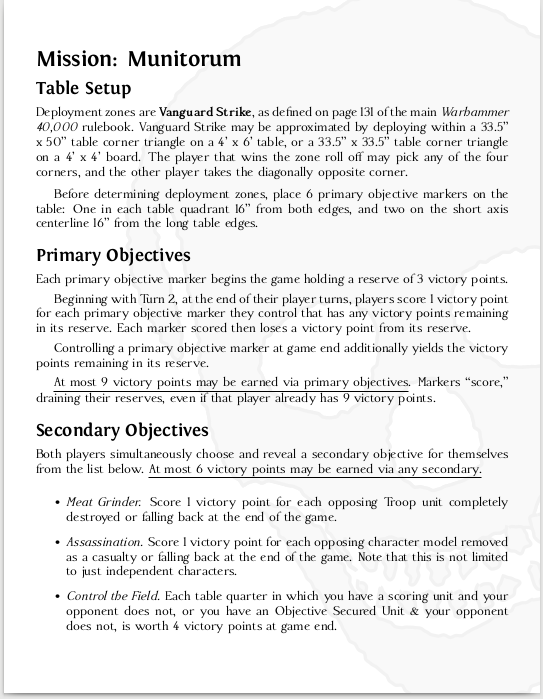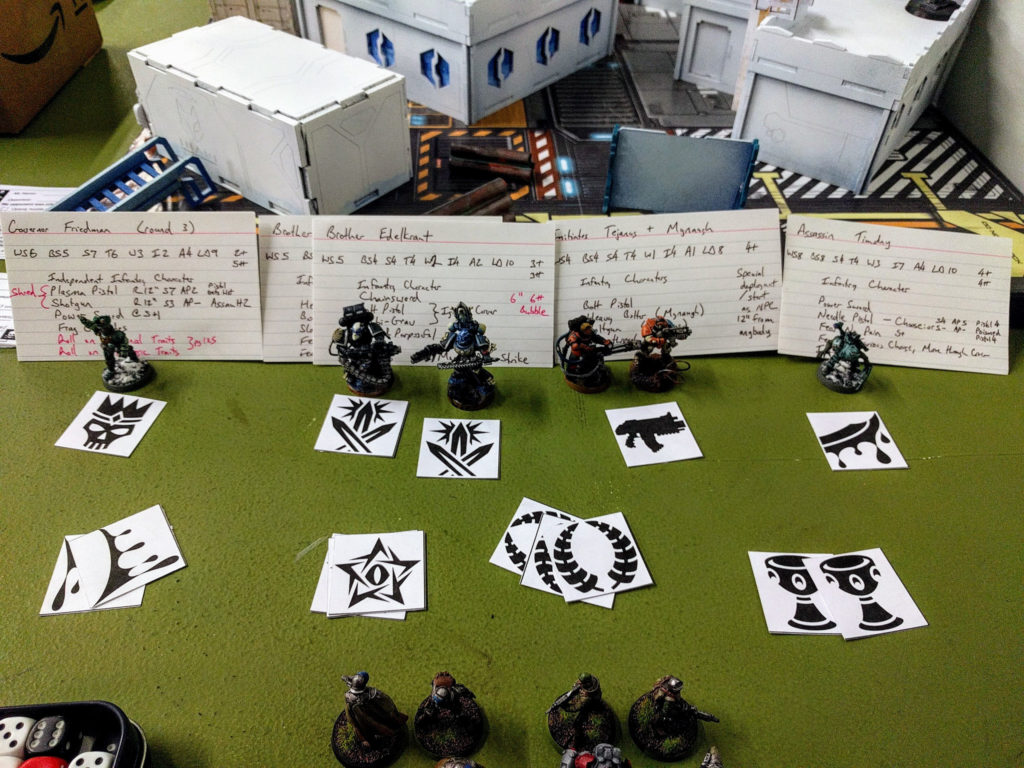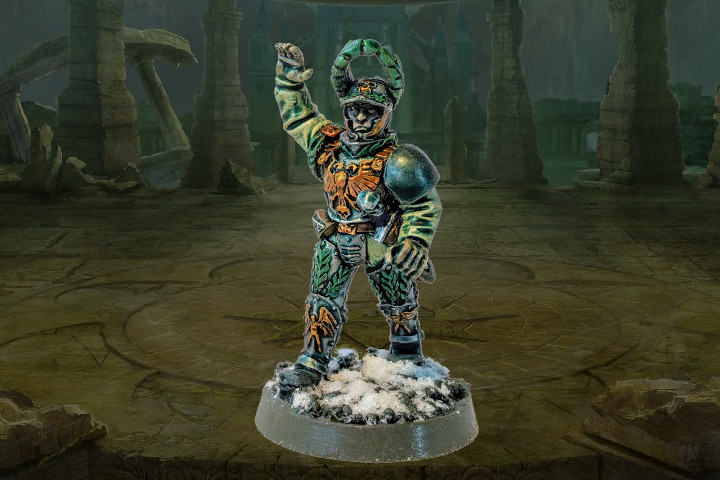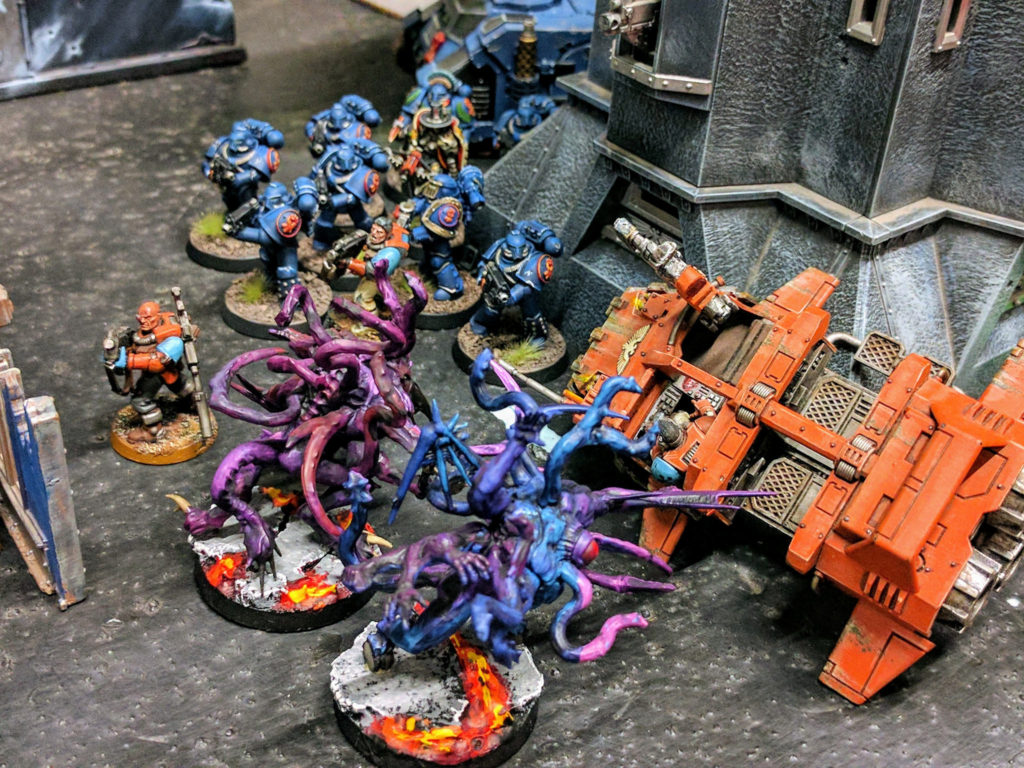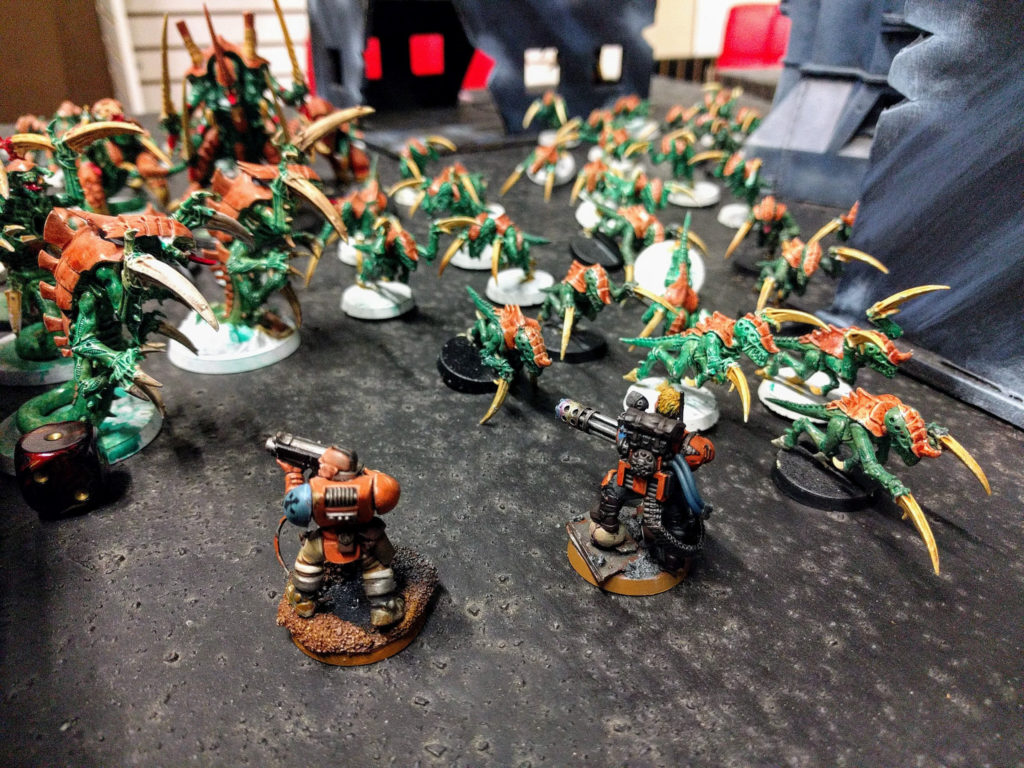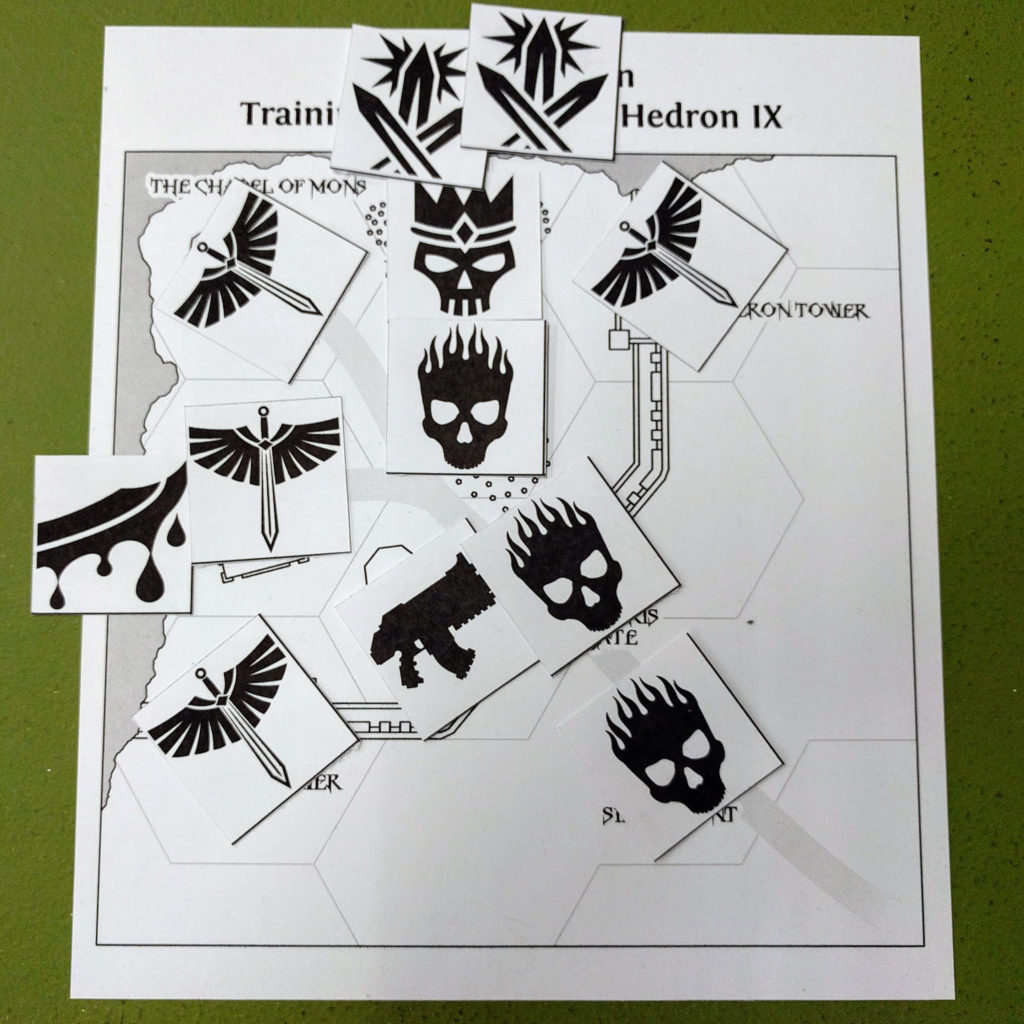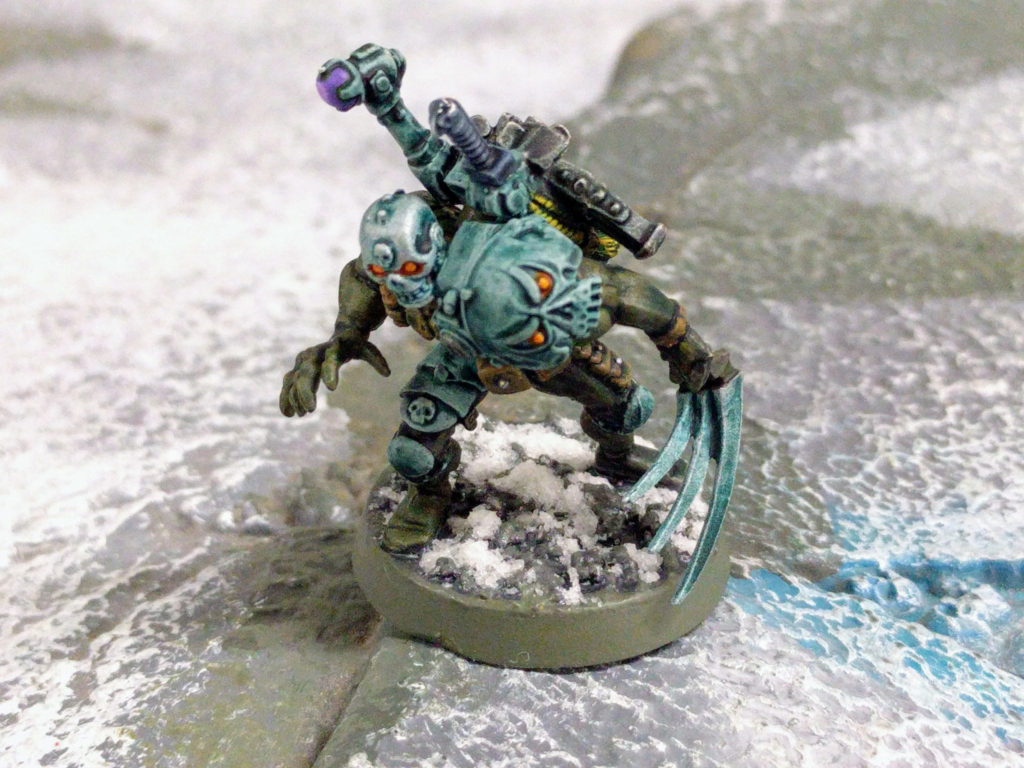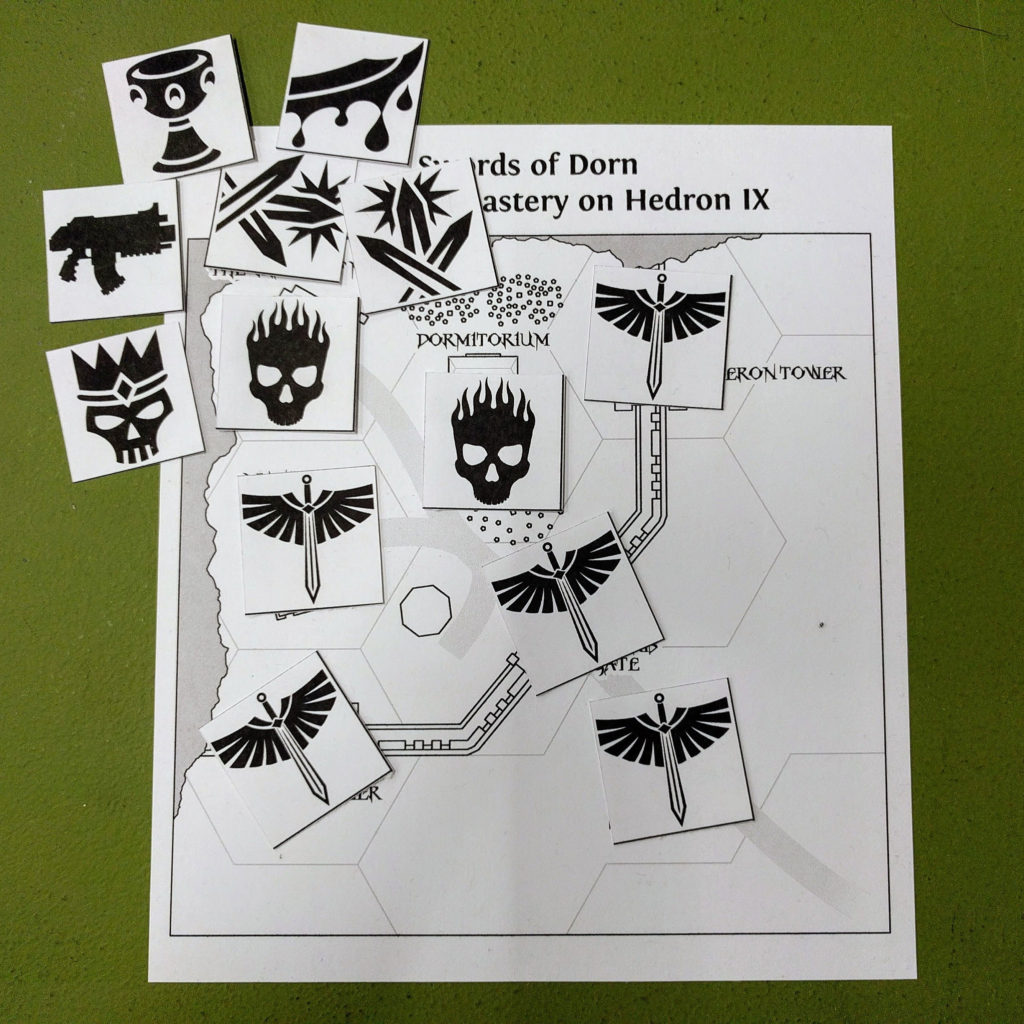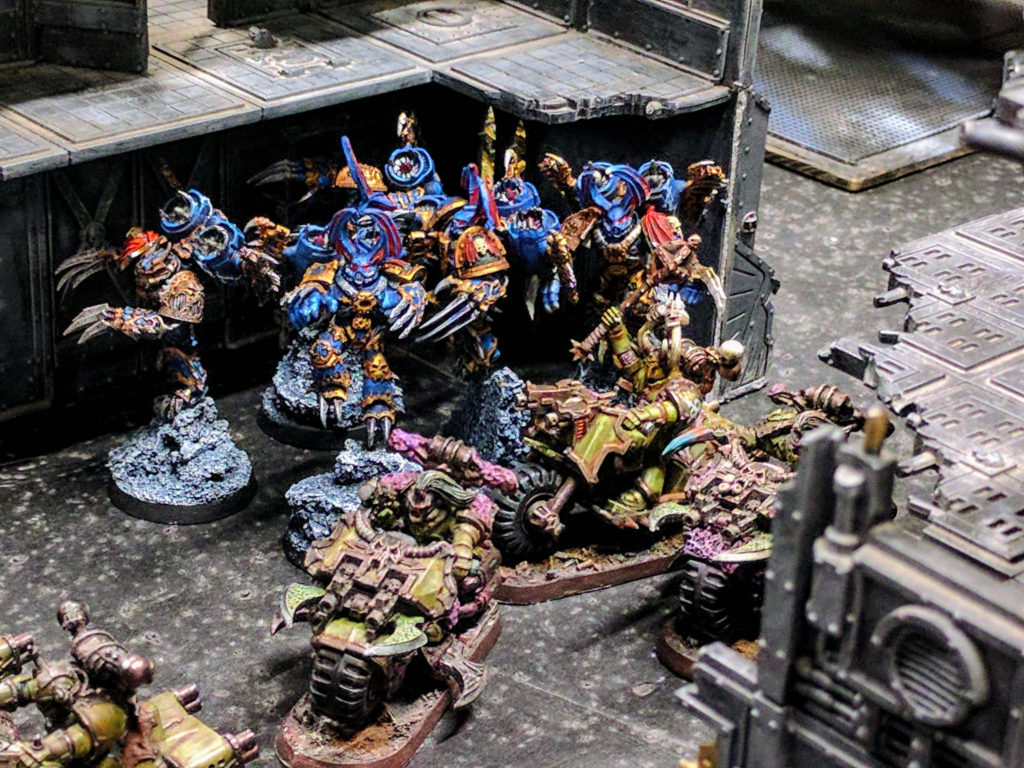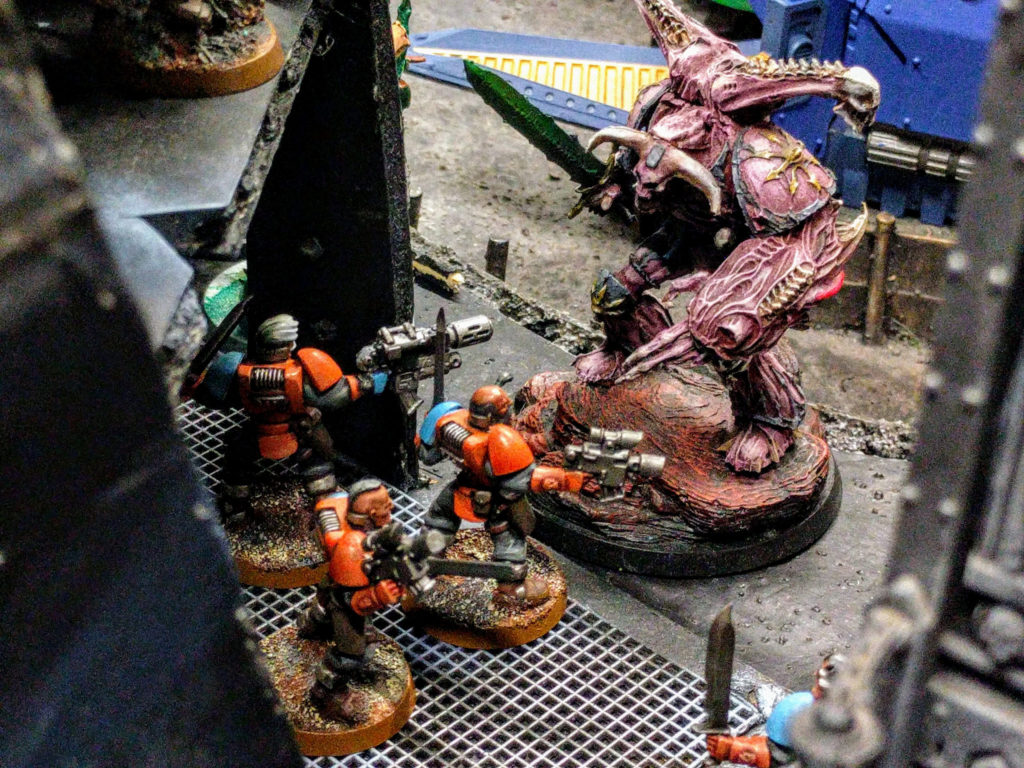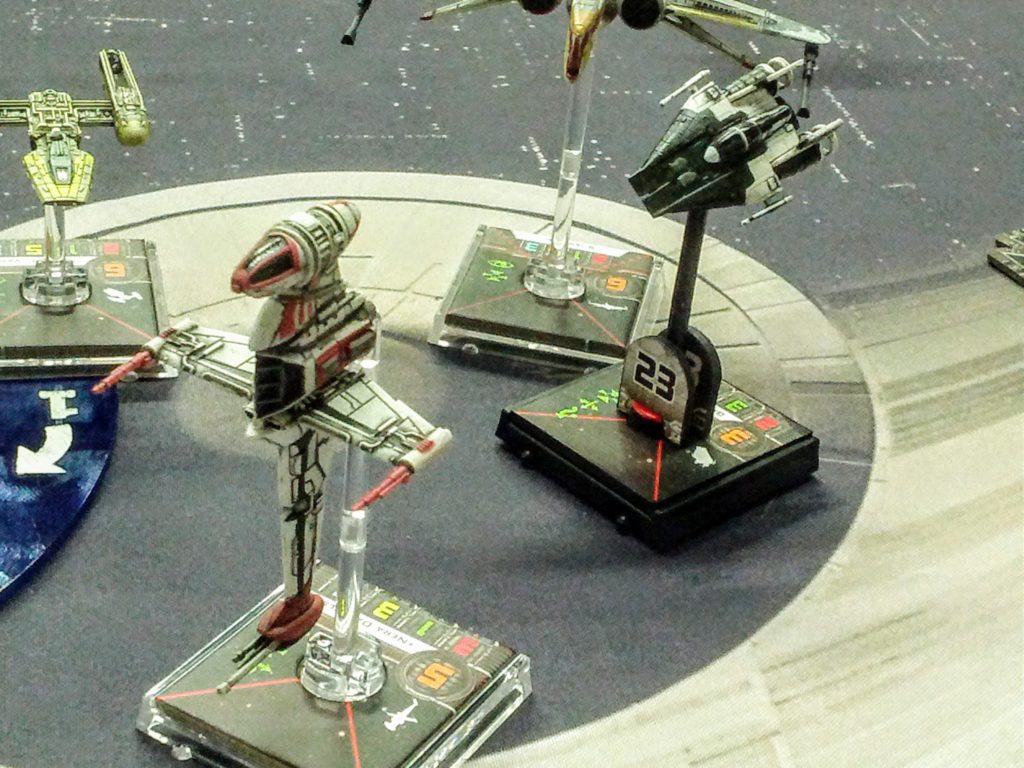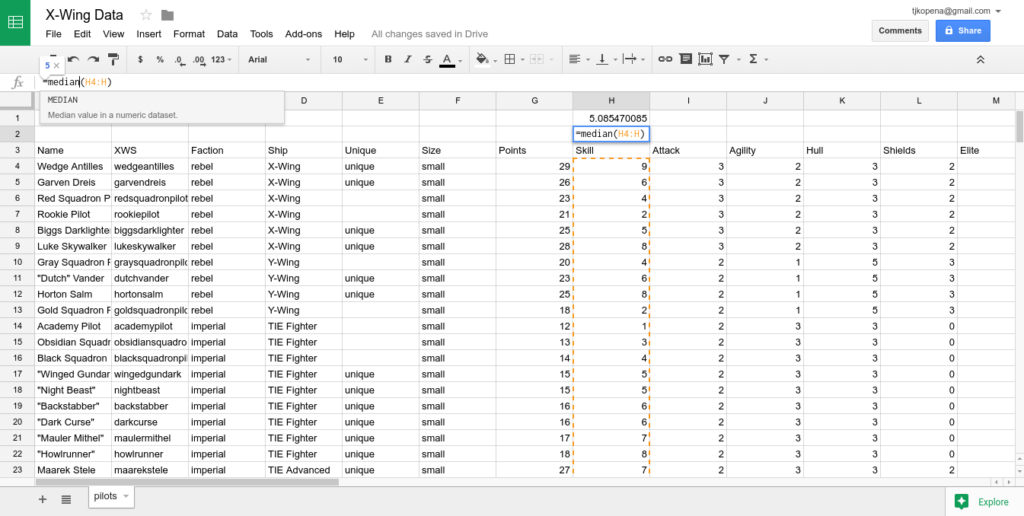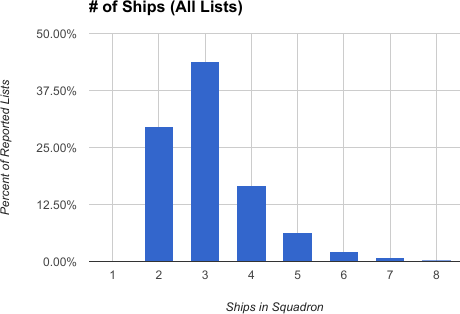
Unfortunately, my friend Sascha is moving away. So we all decided to send him off proper by burning down a monastery of his beloved Swords of Dorn Space Marines!
Fourteen players came together Saturday for our Sword Sworn one-shot narrative campaign. Many heroes were made, villains created, and a ton of great games fought, with literally not a single unpainted model in play. This is a quick recap of the action. Many more photos are available via Flickr or Facebook.
Backstory
Brother Mynaugh’s eyes swept the grounds from his perch in the east tower. Even with his superhuman vision he couldn’t see the group of his fellow initiates he knew would be assembling outside the chapel for night training beyond the walls. So soon now they would all deploy to the 10th company, full and true battle brothers of the Swords of Dorn.Shattering his moment of reverie, the jaw of a servo skull in the tower’s cogitator bank suddenly sprung open and began emitting a piercing inhuman shriek. As Mynaugh looked on in the dim red lighting another and then another followed suit. The import came to the scout like lightning. He whirled around. Far on the horizon, faint lines streaking from orbit. This was no expected landing, no scheduled drop training. Mynaugh tugged his bolter off its wall bracket and pulled it close, not believing this to be any suprise drill either. Perhaps the initiates’ time had come early…
On the quiet planet of Hedron IX, the Swords of Dorn maintain one of their chapter’s training monasteries. This one specifically focuses on training Scouts in the art of piloting Landspeeder Storms to swoop onto objectives in turn five. The monastery has unexpectedly come under attack by the Blood Fed, a wretched mob of traitors, xenos, and galactic refuse come treacherously from their hiding holes to avenge imagined slights and punish the ostensibly vainglorious Swords of Dorn. Opposing them, in their moment of need the Swords of Dorn have called the many valiant allies with which they have shared mutual oaths over the decades to defend both honor and body to join them under the banner of the Sword Sworn alliance.
Map
Our campaign begins with the invaders amassed at the monastery walls. The campaign is played over seven major regions of the chapter monastery:
- The Siege Front where the Blood Fed are encamped;
- The Primaris Gate, Cawe Tower, and Saleron Tower keeping them at bay;
- The Dormitorium where the monastery’s residents live;
- The Munitorum where the Landspeeder Storms and other equipment are kept;
- The Chapel of Mons where initiates pray and train in the combat arenas.
The Blood Fed start in control of the Siege Front and are working toward the chapel: Even if the Sword Sworn successfully rebuff them in the larger battle for the monastery, the Blood Fed’s leader and his personal army advances forward each turn.
There are three separate measures of success for the campaign—
- Tactical: Taking/preserving the monastery (controlling a majority of the regions);
- Strategic: Wrecking/preserving the Swords of Dorns’ recruit pipeline (higher total campaign points earned, a combination of victory points and campaign rewards);
- Campaign: Looting/preserving the chapel relics (controlling the chapel).
Missions
A specific mission is associated with each map region, with the alliances alternating choosing regions to attack each round and thus the missions for each match to use—
- Siege Front: A kill points style mission;
- Towers and Gate: A breakthrough mission in which players place objectives whose worth is determined by how far they are from the player’s table edge;
- Dormitorium: Both sides work to capture or rescue the many non-combatants enabling a Space Marine chapter’s operations, represented by Civilian NPCs.
- Munitorium: Both sides work to destroy or extract equipment, represented by objectives that may be scored a finite number of times;
- Chapel: An open battle with players vying for their choice of a combination of specific objective markers or kill points.
All of these are well tested and tournament-ready, based on our standard scheme of 20 victory points: 9 for primary objectives, 6 for secondaries, 5 for tertiaries. Each mission has a short list of secondary objectives from which players choose individually. This enables players to make strategic choices and play to their strengths, e.g., doubling down on killing versus objective grabbing or vice versa.
Special Characters
There are multiple special characters at large in the campaign, including the aforementioned leader of the Blood Fed. In addition to their in-game presence, each special character awards 10 campaign points each round to the alliances for either their survival or death (interpreted as being forced to retreat) as appropriate.
The only characters known to both teams initially are the Scout Initiates Mynaugh and Te’Janus. Having been caught in the initial fighting, they are now swept away in the battle. Completely overwhelmed and seriously questioning signing up to be Space Marines, sheer luck just barely lets them survive, carried from one awful circumstance to another. This is represented by the Initiates being randomly assigned to a match each round, in which they are placed somewhat randomly between the two forces and huddle down until saved by the Sword Sworn or overrun by the terrifying invaders.
Tokens
In addition, there are three types of tokens given out at various points—
- Blood Favor: The very first unit across the event to claim First Blood each round gets a Blood Favor which it may discard to ignore D3 wounds/damage.
- Blessing: The lowest scoring players on each side each round get a Blessing from their gods or the Emperor, which they may discard to reroll any single die.
- Relic: Each alliance choose one final round match in the chapel to be for the relic they consider most important, earning or losing an extra 10 campaign points by holding the central objective or not. The token may be revealed to make all runs, flat outs, and charges +D3 inches that player turn. Players may choose objectives in this mission, so the opponent may not necessarily care about the central objective unless this revelation is made.
All of the tokens may be used at any point, and carry into the next game if not used.
Campaign
Appropriately enough, the Blood Fed wound up comprised of primarily Chaos Marines, a few Space Marine contingents apparently having just thrown in their lot against the Emperor, and a band of Tyranids come for the feast. Facing off against them, the Swords of Dorn were backed by a full host of Space Marine loyalists, Tempestus Scions, and an Emperor’s Fist Armoured Company.
As kind of a going-away party we wanted everybody to get a chance to play with multiple people. So we played rotating doubles, with the alliances choosing which of their players to team up each round. After some quick strategy discussion about first round teams and missions, the campaign was on!
Round 1
Scout Initiates Mynaugh and Te’Janus find themselves amid the heaviest fighting, defending the Primaris Gate. Caught without any support, they’re exposed to a massive charge by a ravening horde of Tyranid monsters. Mynaugh lays into the horde with his minigun, but both barely escape the Red Terror.
The Blood Fed’s leader is revealed by his thrust against the Primaris Gate as the Planetary Governor Friedman, unsurprisingly turned traitor. More is at hand though then just a minor rebellion as Governor Friedman is clearly being rewarded for his actions, growing in power and size as the blood flows.
Outside the gates, the Sword Sworn gamble on a counter-offensive, attacking into the Siege Front. They are eventually rebuffed, but at the worst moment the Warp-fired visage of Brother Edelkraut, a storied hero of the Swords of Dorn presumed long dead, appears and empties his wrath into the invaders.
Outcome: No change in regions, but the Governor breaks through the Primaris Gate.
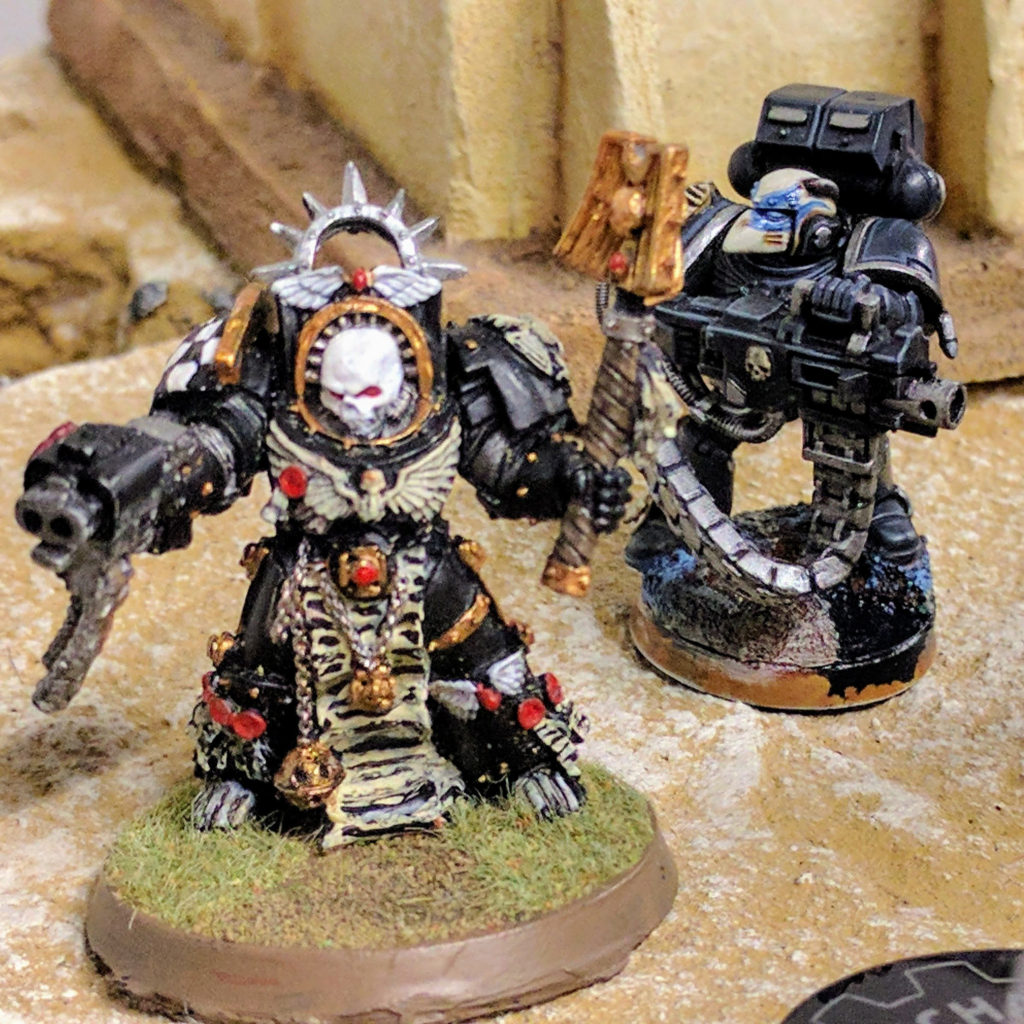
Presumed long dead Brother Edelkraut appears from the Warp to support a Lamenters Chaplain in his moment of need.
Round 2
Having barely escaped being eaten, the Initiates Mynaugh and Te’Janus immediately stumble into an even worse horror: The soul corrupting might of Chaos! Still trying to escape the carnage around the Primaris Gate, they’re harried by Raptors and driven toward the maw of Nurgle’s mightiest minions.
His rage growing ever more powerful, Governor Friedman sweeps through the Dormitorium feeding civilians to his dark gods. The Swords’ desperation growing as the heretic works ever closer to the chapel, Brother Edelkraut lives up to his legend, moving so fast from fight to fight that he often seems to be in two places at once.
At the previously quiet Munitorum, the defense forces are overtaken by terror as they suddenly realize there is a silent stalker among them: The governor’s secret henchman Assassin Timday appears at the airfield and begins hunting down Tempestus Scions.
Outcome: The Blood Fed cleave a clear path from the Siege Front through the Primaris Gate and the Dormitorium to the very edge of the Chapel.
Round 3
Now a lumbering hulk, Governor Friedman smashes through the chapel walls and makes his way to stake a claim on a chalice said to have been drunk from by Rogal Dorn himself. Despite dispatching ever more frenetic vengeance, Brother Edelkraut’s furious hauntings are not enough to stop this sacrilege. Meanwhile the twisted Assassin Timday lurks the outer edges of the chapel battle, continuing his persecution of the Tempestus Scions.
Blown by the winds of war from fight to fight, the Initiates Mynaugh and Te’Janus find themselves having gone full cycle, from the very first contact at the Primaris Gate, to the very last fighting at the Chapel of Mons. There they find themselves almost snared in the clutches of the Alpha Legion when an angry company of Lamenters Space Marines comes to their aid just in time. Rallying to their brave example, they join a squad of their brethren Scouts in a suicidal fight to hold the left flank and protect the Lamenters’ main position. At long last the Initiates Mynaugh and Te’Janus have truly learned what it means to be one of the Emperor’s finest.
Outcome: The Sword Sworn make a successful raid into the invader’s encampment as well as retaking the Primaris Gate, but do not stop the Blood Fed’s push to the Chapel of Mons and the precious relics inside.

Ill-fated Brother Maximus, cursed with Black Rage in his Dreadnought armor tomb, surges forward to assault a Chaos Havoc squad.
Outcomes
The Sword Sworn maintain marginal control of their monastery on Hedron IX (Sword Sworn tactical victory). Their recruiting pipeline however is wrecked by the Blood Fed, who have indeed feasted on many of their trainees and destroyed much equipment and supporting personnel (Blood Fed strategic victory). Worst of all, the cursed Governor Friedman manages to loot the Chapel of Mons and makes off with the relics he came to steal for his masters (Blood Fed campaign victory)!
Like so many chapters before them, the Swords of Dorn will have to rebuild from this loss, no doubt to become even mightier warriors for the Emperor…
Awards
Full campaign and individual results are posted here (XLSX). As this was purely a casual narrative event, we awarded the following as small store credit prizes:
- Best Generals: Top overall points in each alliance, encompassing victory points + sportsmanship + army appearance (a 5 point rubric for minimum standards);
- Craftsperson: First and second place in player votes for best army appearance;
- Lucky Warriors: Our two primary prizes were drawn from a raffle, each player having earned 2 tickets for a loss and 1 ticket for a win.
Jake C with his Tyranid and Brian M with his Ravenguard won the raffle prizes. Steel Thunder Mike and Sam L from the Berks PA Gaming Club took home Best General titles for the Sword Sworn and Blood Fed respectively. A relative newcomer to our Redcap’s community, Fernando V took second in the painting votes with his Crimson Fists while man of the hour Sascha and his Swords of Dorn once more won that ballot, donating his prize to our ongoing Shadow War campaign. Congratulations everybody!
Next Up!
I have a bunch of thoughts on different aspects of this campaign to tweak. But it seemed very successful at creating the feel of a larger story and throwing in lots of fun little bits without being overly complex or unbalancing. A PDF with all the missions, tokens, map, etc., is mostly prepared and will be posted once 8th edition is released and the necessary changes made.
As a bonus, I was blown away by all the amazing armies and models that came out to play. Many under-utilized models made an appearance, particularly among the Chaos Marines. Many more photos are available via Flickr or Facebook.
All in all, I had a great time, everybody else seemed to have a great time, and I hope it was a fitting community tribute to Sascha, who has been the heart of our 40k group the past few years. We’ll miss you, and we’re sorry we burned down your monastery!
For everybody else, if this is the kind of Warhammer 40,000 gaming you crave and you can get to Philadelphia or Washington DC, you should join us for our upcoming LibertyHammer weekend in June and the NOVA 40k Narrative over Labor Day!


